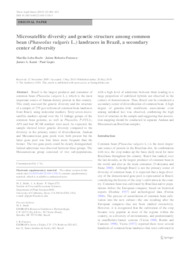Microsatellite diversity and genetic structure among common bean (Phaseolus vulgaris L.) landraces in Brazil, a secondary center of diversity.
Microsatellite diversity and genetic structure among common bean (Phaseolus vulgaris L.) landraces in Brazil, a secondary center of diversity.
Author(s): BURLE, M. L.; FONSECA, J. R.; KAMI, J. A.; GEPTS, P.
Summary: Brazil is the largest producer and consumer of common bean (Phaseolus vulgaris L.), which is the most important source of human dietary protein in that country. This study assessed the genetic diversity and the structure of a sample of 279 geo-referenced common bean landraces from Brazil, using molecular markers. Sixty-seven microsatellite markers spread over the 11 linkage groups of the common bean genome, as well as Phaseolin, PvTFL1y, APA and four SCAR markers were used. As expected, the sample showed lower genetic diversity compared to the diversity in the primary center of diversiWcation. Andean and Mesoamerican gene pools were both present but the latter gene pool was four times more frequent than the former. The two gene pools could be clearly distinguished; limited admixture was observed between these groups. The Mesoamerican group consisted of two sub-populations, with a high level of admixture between them leading to a large proportion of stabilized hybrids not observed in the centers of domestication. Thus, Brazil can be considered a secondary center of diversiWcation of common bean. A high degree of genome-wide multilocus associations even among unlinked loci was observed, conWrming the high level of structure in the sample and suggesting that association mapping should be conducted in separate Andean and Mesoamerican Brazilian samples.
Publication year: 2010
Types of publication: Journal article
Keywords: Diversidade genética
Observation
Some of Embrapa's publications are published as ePub files. To read them, use or download one of the following free software options to your computer or mobile device. Android: Google Play Books; IOS: iBooks; Windows and Linux: Calibre.
Access other publications
Access the Agricultural Research Database (BDPA) to consult Embrapa's full library collection and records.
Visit Embrapa Bookstore to purchase books and other publications sold by Embrapa.

